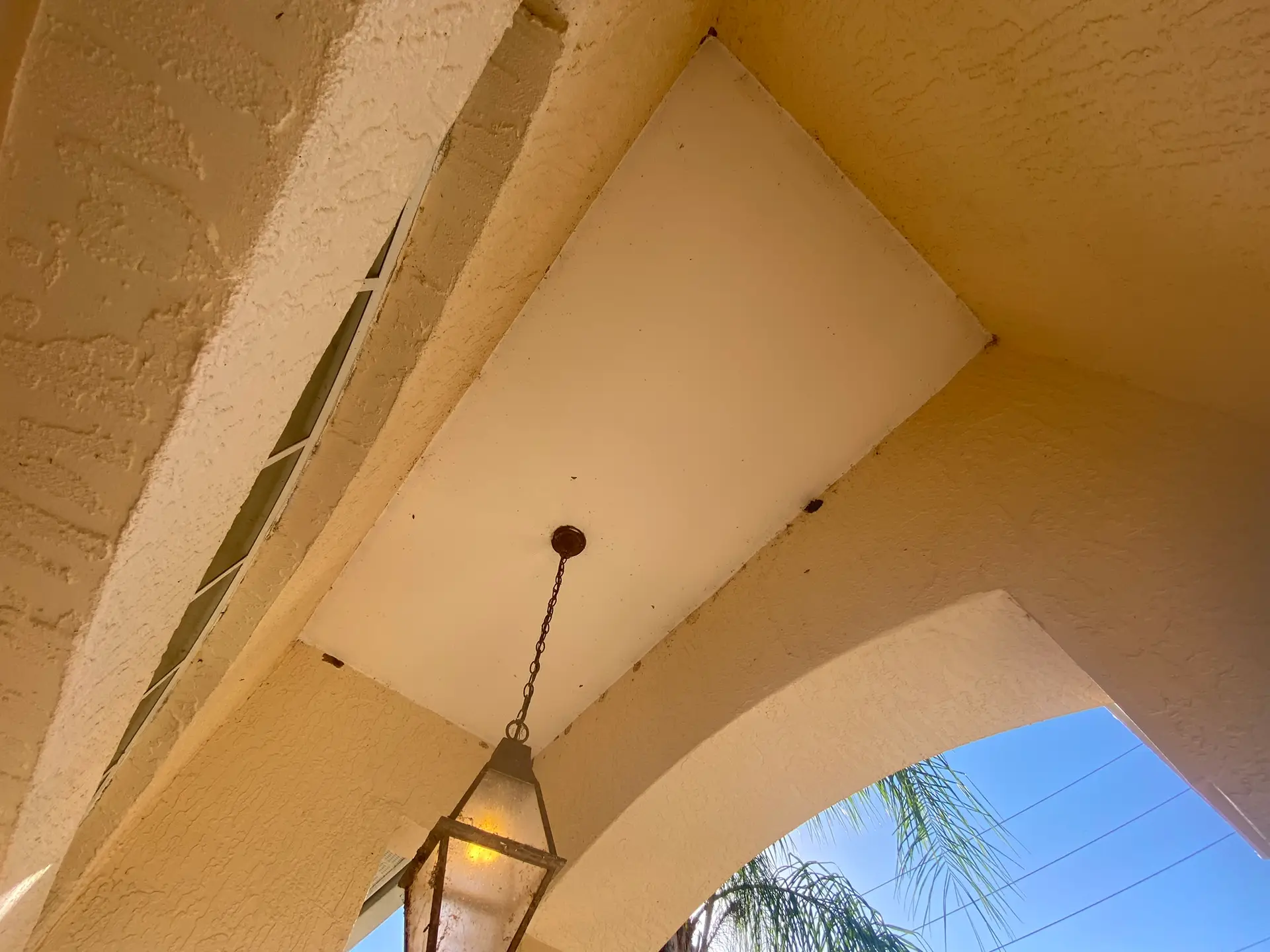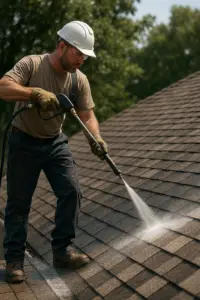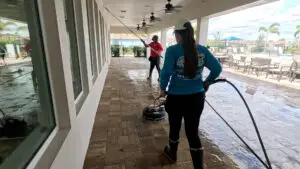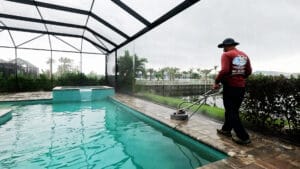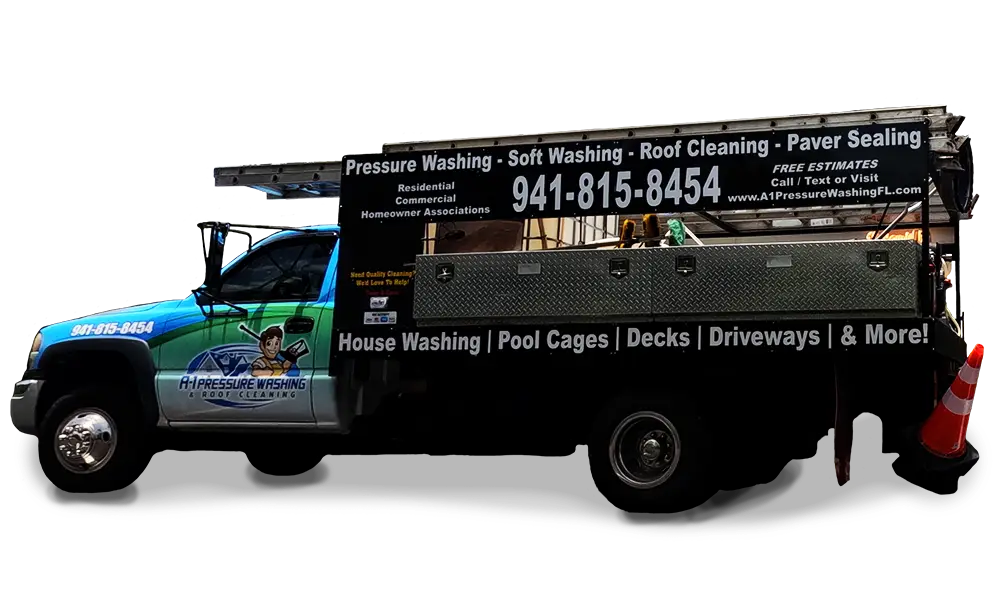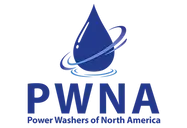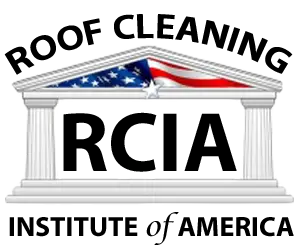As you approach your front door and notice a mud clump in the corner of your entryway, you might wonder, “How to remove mud dauber nest?” If so, this guide is perfect for you!
What is a Mud Dauber Wasp?
While it might be concerning to discover a mud dauber nest at your home, there’s no need to worry. Mud daubers, often referred to as dirt daubers or mud wasps, are solitary wasps known for their unique nest-building behavior. Unlike social wasps, mud daubers do not live in colonies and are rarely aggressive and generally peaceful, posing little threat as they rarely sting. Commonly called thread-waisted wasps due to their narrow midsections, these creatures are fascinating due to their solitary nature and role in helping controlling spider populations around our homes.
Florida Mud Dauber Species and Their Life Cycle
In Florida, the most common mud dauber wasp is the black and yellow mud dauber, scientifically known as Sceliphron caementarium. This species is easily recognizable by its black body with yellow markings and is known for its solitary behavior and distinctive mud nests. Other common species in Florida include the organ pipe mud dauber and the blue mud dauber, each with their unique nesting behaviors and preferences. These wasps play a beneficial role in controlling spider populations, as they primarily prey on spiders to feed their larvae. This is very import as they are known to seek out and capture black window spiders.
Mud daubers vary in color and size, but all share a common life cycle:
Mud dauber wasps go through four life stages: egg, larva (which looks like a worm), pupa (cocoon), and adult. They can have one or two generations each year, depending on the type. In spring, the pupae from the previous year turn into adults. Female wasps then build new nests and start catching insects or spiders to put in each cell of the mud nest. They sting and paralyze their prey, which is important because dead prey would rot. The wasps lay eggs on these paralyzed prey inside the mud cells and seal them up. The eggs hatch into larvae that eat the prey, then turn into pupae that stay over the winter.
The next spring, these pupae become adults and start the cycle again. Adult mud daubers eat plant nectar, honeydew, and fluids from the insects and spiders they catch.
What Do Mud Dauber Nests Look Like?
Mud dauber nests are easily identifiable by their distinctive mud constructions, which are often found on sheltered building sides, under eaves, corners of window frames, inside garages, and they seem to love to build them in our front door and entry way areas. It is the first thing we see as we walk into our homes, but our front door lights attract many other bugs that they love to feed on. These nests typically look like small tubes or pipes made of mud and can vary in shape depending on the species.
How Does a Mud Dauber Build Its Nest?
Mud daubers collect mud from damp locations such as the lakes inside our gated community, and form it into balls. They then construct their nests by meticulously molding these mud balls into tubes or chambers.
Nest Construction: A single female mud dauber can build and provision a nest on her own, showcasing their solitary nature.
Site Selection: They prefer sheltered areas that protect the nest from the elements and predators.
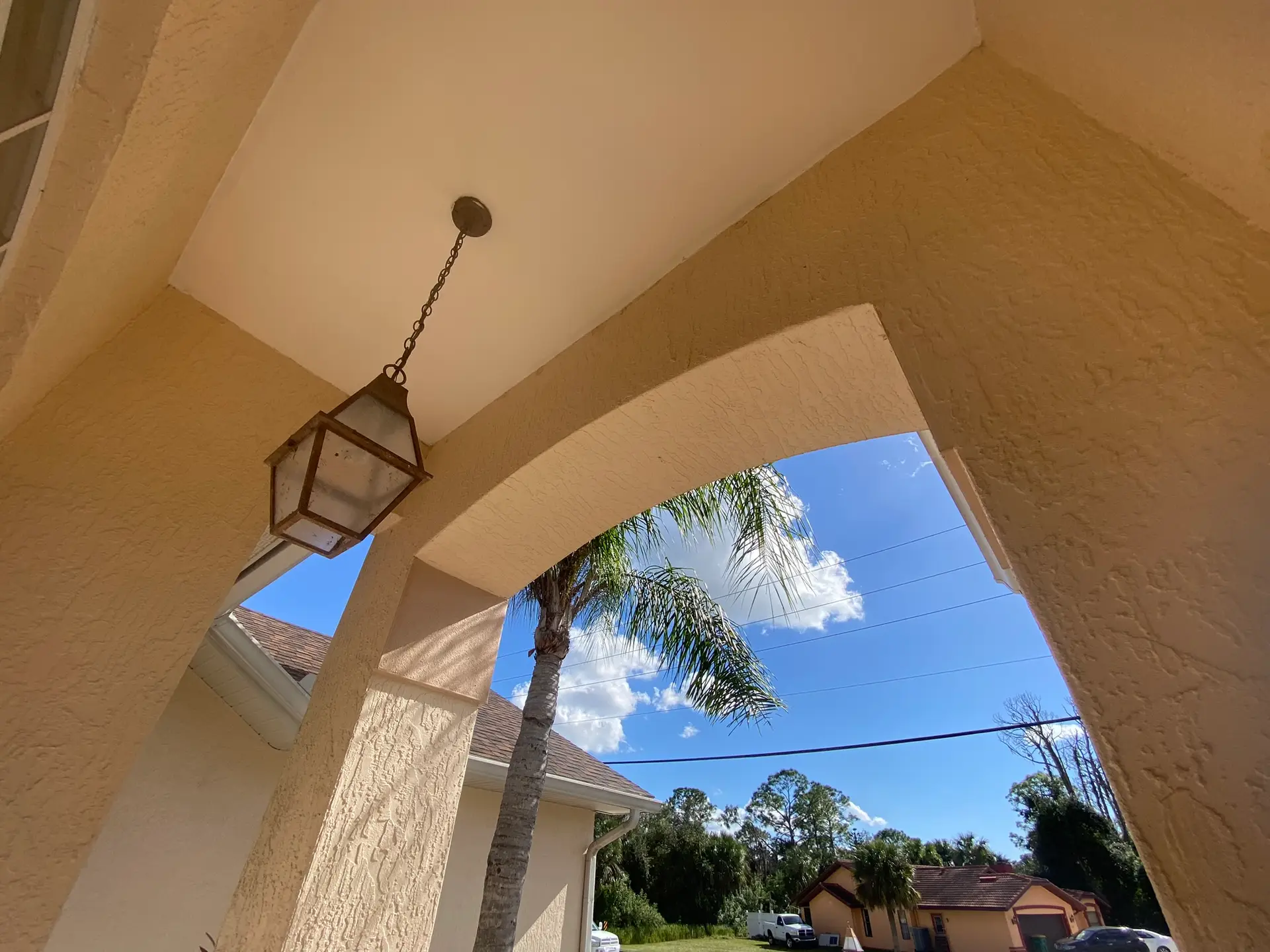
How to Get Rid of a Mud Dauber Nest
Removing a mud dauber nest is generally straightforward, often requiring just water and a brush. However, here are several careful steps to ensure both safety and effectiveness:
Identify Active vs. Abandoned Nests: Check the nest during daylight hours for activity. Active nests will be smooth and intact, while abandoned nests may have holes. Even though mud wasps are generally not aggressive, this doesn’t mean they won’t sting if you try to disturb their nest.
Safety First: Wear protective gloves and glasses to prevent any accidental stings or mud splatter. When using a ladder, ensure it is positioned on a stable, even surface. Additionally, it’s a good idea to have a friend or family member assist by holding the ladder steady for extra safety.
Removal Tools: Use a putty knife, scraper, or stiff bristle brush such as a tile and grout scrub brush to break apart the mud nest from the surface. For hard-to-reach areas, you’ll need a ladder or you can attach your removal tool to an extension pole, allowing you to scrape away the mud nest from the safety of the ground.
Clean the Area with water: After removal, clean the surface with fresh, low pressure water such as from a garden hose to remove remaining mud.
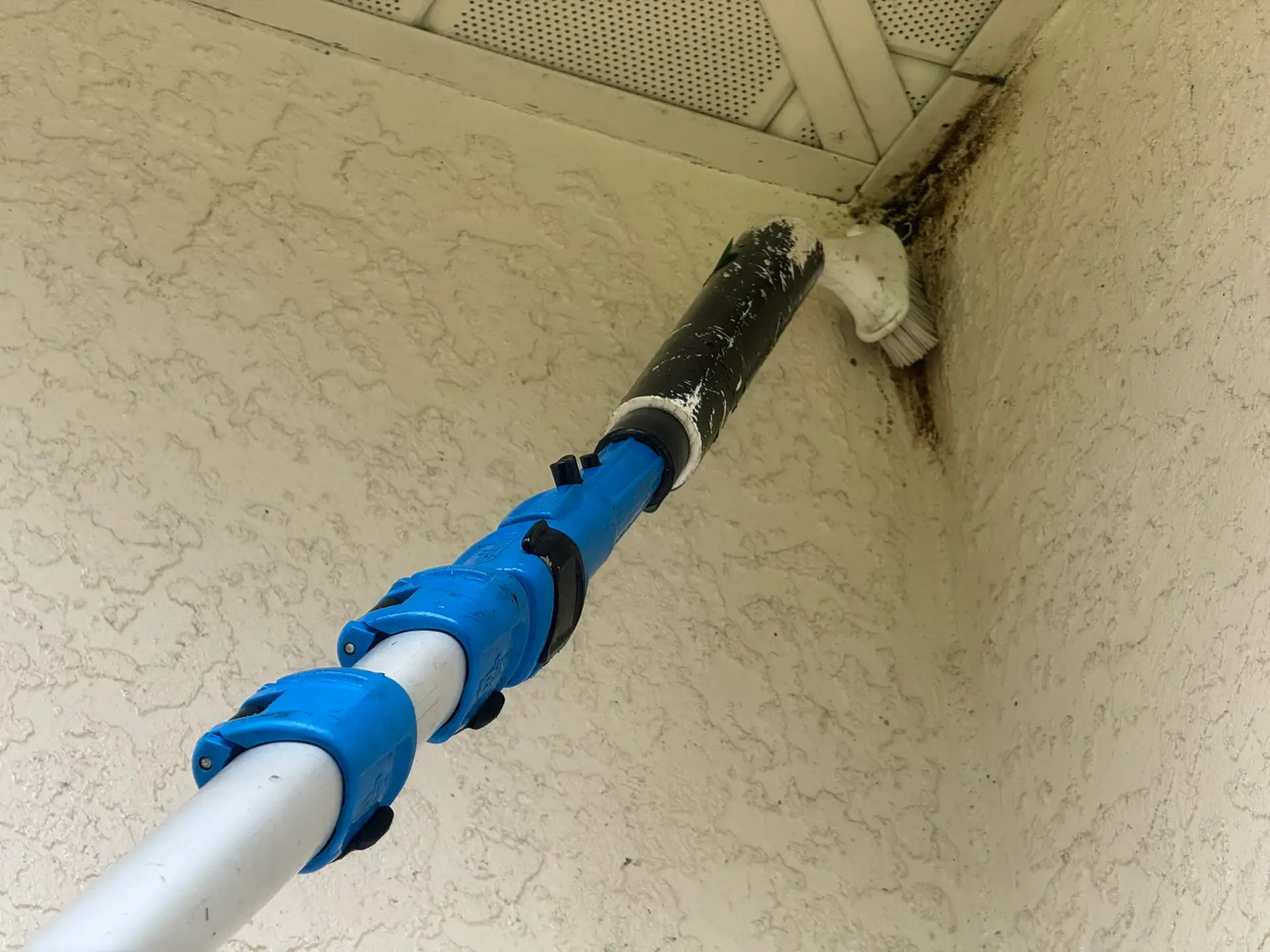
How to Remove Mud Dauber Nests from Stucco
Stucco surfaces require gentle handling to avoid damage to the painted surface or chipping apart your stucco:
Break apart the mud nest: Use a stiff bristle brush such as a tile and grout scrub brush to break apart the mud nest from the surface. If you are not comfortable on ladders, you can attached your brush to an extension pole to reach those higher areas in corners of walls and ceiling.
Minimize Water Pressure: Use a spray bottle filled with warm soapy water to soften the nest residue before scrubbing it again with your brush, and lightly rinse with fresh water.
How to Remove Mud Dauber Nest Stains
Mud dauber nests can leave stains on painted surfaces after you have removed the main clump of mud, especially if they have been in place for a long time.
Stain Removal with vinegar: Apply a mixture of water and vinegar to the stain and let it sit before scrubbing with a soft brush. Rinse Thoroughly: After scrubbing, rinse the area with clean water to remove any vinegar residue.
Stain Removal with All purpose Cleaner or Degreaser: Apply a mixture of 3 parts water and 1 part all purpose cleaner or degreaser to the stain and let it sit for about 15-30 seconds before scrubbing with a soft brush. You may need to repeat this step several times, before the stain is completely removed, but if the nest was in that location for a long time, then it may have stained the area with a faint shadow, and you will need to apply a fresh coat of paint to completely cover it up.
Professional cleaning is just a click away!
We hope this article has helped you understand how to identify mud wasps and the different techniques to remove mud dauber nests from your home. If you find the task too daunting, we’re here to assist. Our house washing service includes the application of eco-friendly soap to your home’s exterior surfaces such as gutters, soffits, fascia, walls, exterior window frames, and front entryways. This process helps break down mildew, algae, cobwebs, and mud dauber nests. We meticulously scrub the nests to dissolve the mud clumps and then perform a soft wash with fresh water. Following that, we apply a light degreaser to any remaining stains, scrub again, and wash away the residues, leaving your home’s exterior and entryway clean and refreshed.
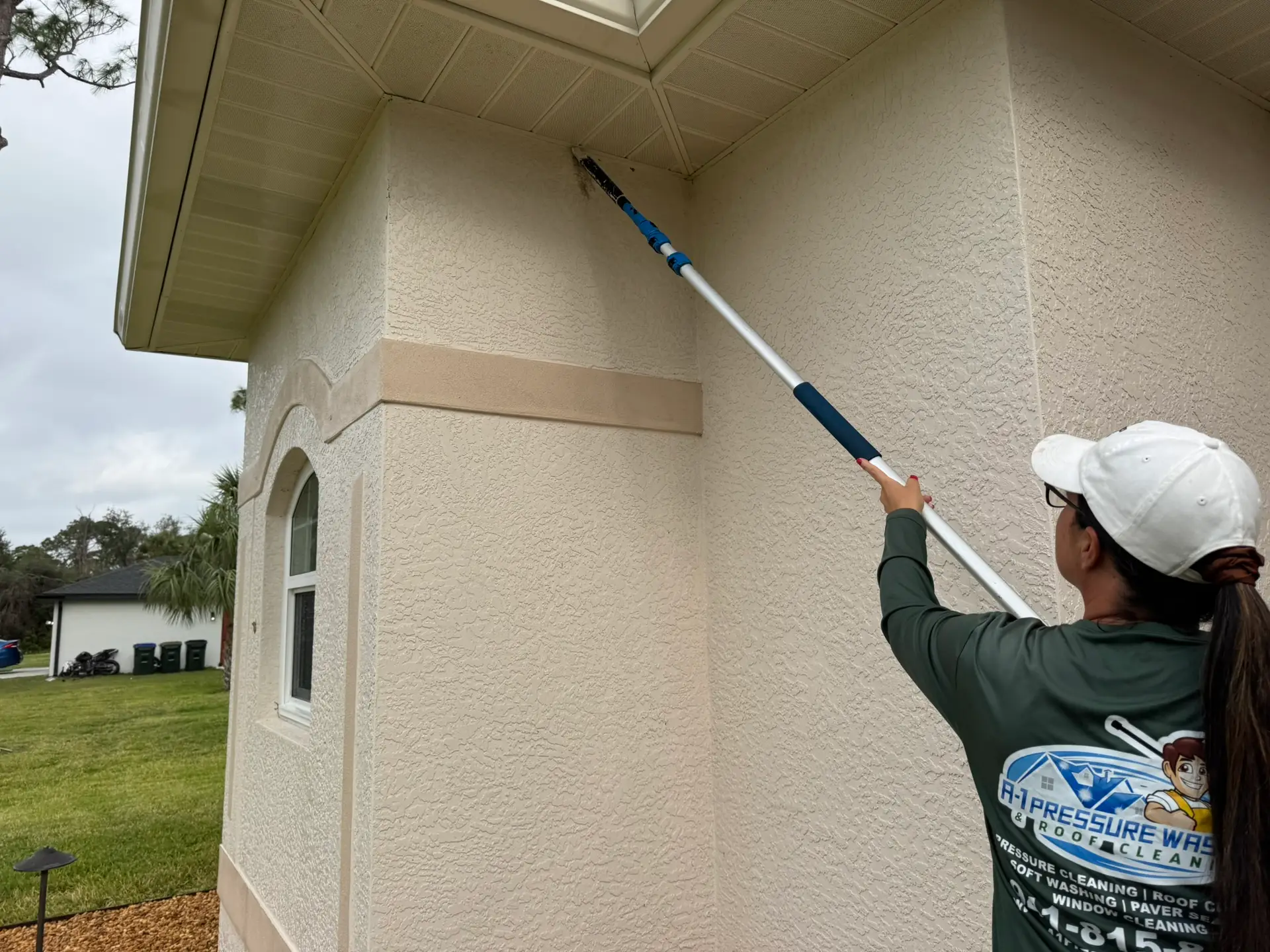
Professional cleaning is just a click away!
We hope this article has helped you understand how to identify mud wasps and the different techniques to remove mud dauber nests from your home. If you find the task too daunting, we’re here to assist. Our house washing service includes the application of eco-friendly soap to your home’s exterior surfaces such as gutters, soffits, fascia, walls, exterior window frames, and front entryways. This process helps break down mildew, algae, cobwebs, and mud dauber nests. We meticulously scrub the nests to dissolve the mud clumps and then perform a soft wash with fresh water. Following that, we apply a light degreaser to any remaining stains, scrub again, and wash away the residues, leaving your home’s exterior and entryway clean and refreshed.

